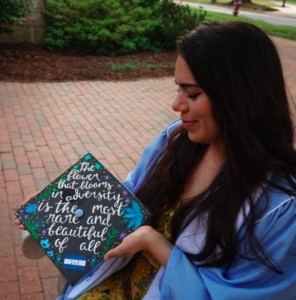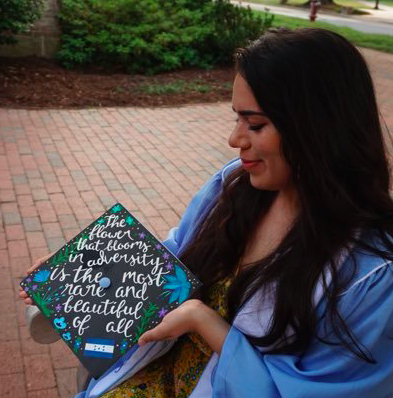 Navigating a queer identity can be complicated — especially when you also have other marginalized identities. As Pride Month and various community celebrations have begun, I’ve thought more about the intersection of my identities.
Navigating a queer identity can be complicated — especially when you also have other marginalized identities. As Pride Month and various community celebrations have begun, I’ve thought more about the intersection of my identities.
I identify as Latinx; my family’s roots are in Esquías, a small municipality in Honduras. This has been my second Pride Month since I officially became vocal about my identities as asexual and pansexual. The intersections of these identities make Pride Month a complex time, as I imagine it does for other queer individuals of color.
While I understand that historically, queer activists of color paved the way for these celebrations through their organizing efforts during the Stonewall Riots, the discourse in white queer circles does not always recognize this.
Like many other queer people, I have plans to attend Pride celebrations, watch “First Kill” on Netflix, and spend time in community spaces with other queer individuals. However, I have also spent the first few weeks of Pride Month navigating feelings of loneliness and confusion.
Unfortunately, the understanding and creation of mainstream queerness has been shaped by white queer people and their understanding of what it means to be queer. The construction of white dominance in queer spaces has left me grappling with my own identities, specifically my experience being Latina. While I find pansexuality central to my queerness, I want to focus on my experience as a Latina on the asexual spectrum.
Since I understood what being asexual was as a teenager, I felt a connection to the term and identity. While I feel aligned with identities on the asexual spectrum, I feel the closest to being “gray-asexual,” meaning I align somewhere between being asexual and being sexual.
When I found out the meaning of asexuality, it felt like things clicked into place. As an adolescent, topics like sexuality, sex, and dating were central to conversations and social milestones. It was difficult for me to understand these aspects of myself while also not feeling sexual attraction in the way other people expected me to.
I had crushes and found people charming, but the idea of having sex without an emotional connection made my stomach churn. As an adult, I began to feel more comfortable with my boundaries and understanding of sex and sexuality. However, I also understand that people’s perceptions and expectations of us impact how we navigate our various identities.
No matter how confident I become in my queerness and asexual identity, I know that these perceptions of my identity impact how I interact with my own communities. I was constantly worried about how I presented myself: Were people recognizing my queerness? How was I being labeled by the people around me? As I’ve grown, these concerns have lessened, but the thoughts are still burrowed in the back of my mind.
Being Latina was another aspect of my identity that was at the forefront of my mind as a teenager. In pop culture, being Latina means being characterized as sexual. Popular notions of what it means to be a Latina can be found in various media representations, such as Gloria from “Modern Family” or Ana Ortiz from “Devious Maids.”
While sexual expression is diverse, there are both Latinx and non-Latinx individuals who are on various parts of the sexuality spectrum. Latinas, along with other ethnic minorities, are exoticized and have their humanities reduced down to simplistic characterizations of being “sexy.” These assumptions about “Latinas being sexual” are imposed by people who didn’t consider what my life as a three-dimensional person could be.
Not meeting their expectations of what a Latina “should” be meant my connection from my heritage was severed in their eyes. I didn’t “perform my culture” in a way that was suitable to them; therefore, I was not “authentic” enough.
My queerness — more specifically, my asexuality — made me feel invalid as a Latina because I existed outside of the expectations people placed on me. In white queer spaces, my identity as a Latina functioned similarly. As mentioned, what it means to look, act, and be queer was created to validate only white constructions of queer identity. If that construction is not extended to you, it is assumed that you identify as straight, so you’re not prioritized in queer narratives.
Not only does this notion lend itself to prioritizing heterosexuality, but it also centers the narratives and ideas of those with the most social capital within the queer community.
A core example of this was during a discussion with one of my white peers in graduate school. Without delving into too much detail, we came to a disagreement, and he highlighted his identity as a queer man as a core reason for his stance. It was in this moment, and similar moments after this, that I understood that in the popular narrative of what white queers have constructed as “mainstream queerness,” I didn’t meet his preconceived notions for what a queer individual should be. This incident was not isolated, but stands out as a core moment in being forced to recognize who is “granted” the identity of queerness. Additionally, my peer’s comments convey a larger understanding about who dominates popular understanding of queer identity.
It might seem that being queer and Latina are mutually exclusive. This is something I profusely disagree with. Rather, it is the imposition of what these identities “should” mean and not the variety of ways they can function and appear.
My queerness and my identity as a Latina cannot be unwoven; the existing of these two identities complement my experiences and how I relate to the world. While I am still understanding and unlearning internalized perceptions of how I am expected to act or present myself, Pride Month will (and should) continue to be a celebration of how we can authentically be ourselves.
Women AdvaNCe compiled a list of Pride Month events happening this June! You can check it out here.
 Jessica J. Mencia (she/her/ella), MSW is a PhD student at the University at Buffalo School of Social Work and an alumni of the University of Chapel Hill. Her research centers on abortion access and sexual rights and risk-taking in marginalized young women and girls. She can be contacted at jjmencia@buffalo.edu.
Jessica J. Mencia (she/her/ella), MSW is a PhD student at the University at Buffalo School of Social Work and an alumni of the University of Chapel Hill. Her research centers on abortion access and sexual rights and risk-taking in marginalized young women and girls. She can be contacted at jjmencia@buffalo.edu.

There are no comments
Add yours